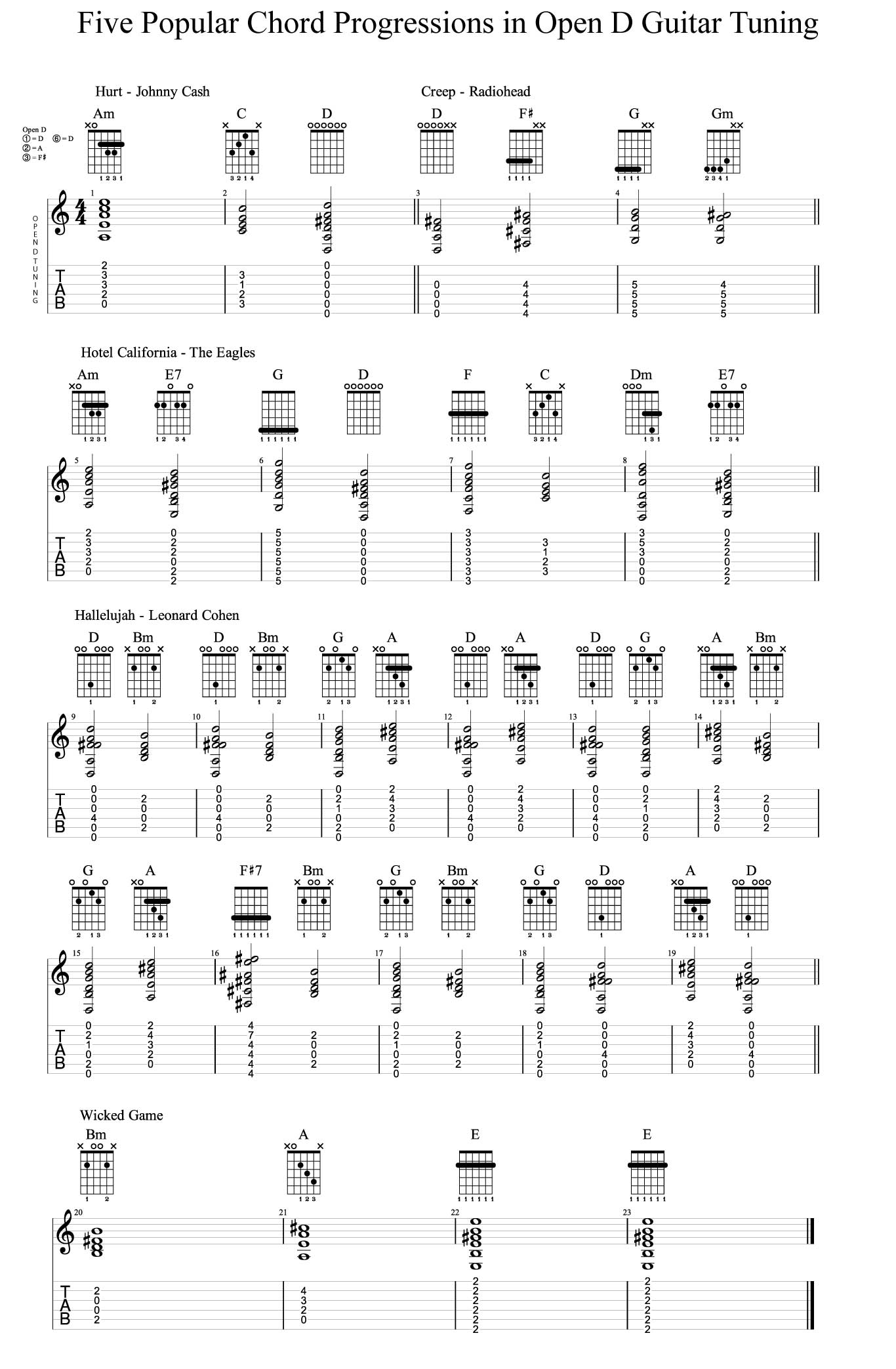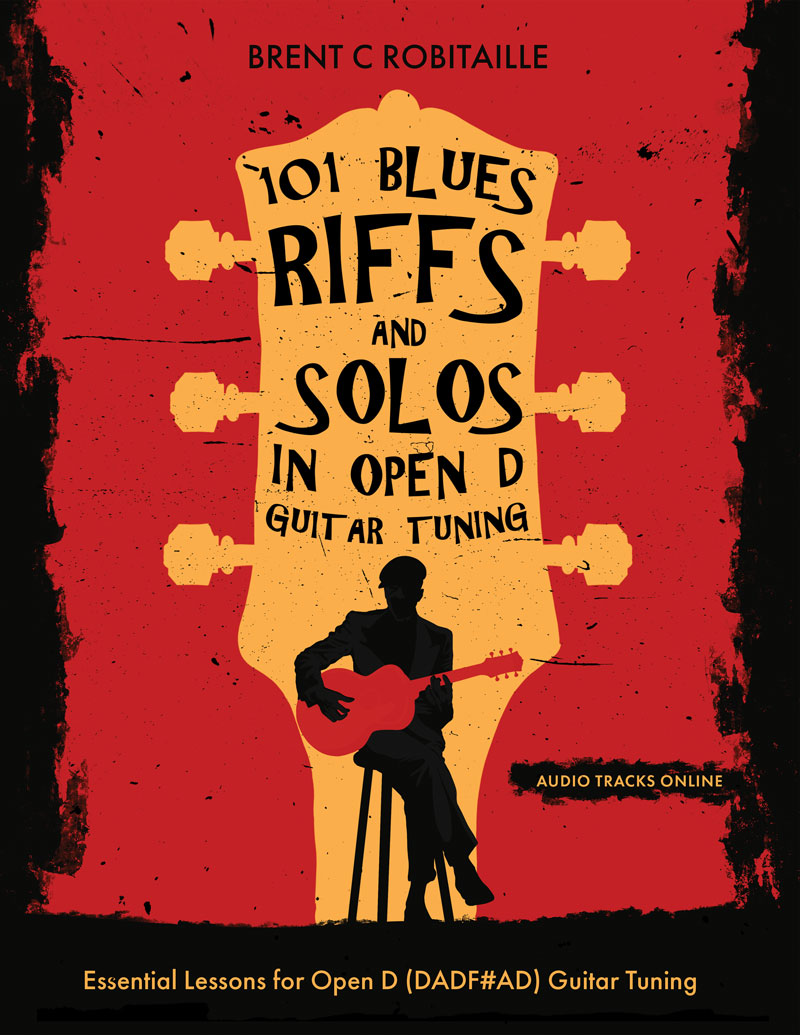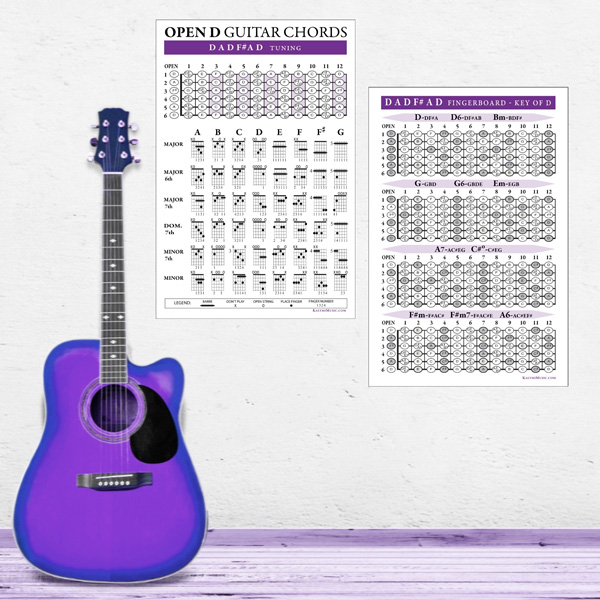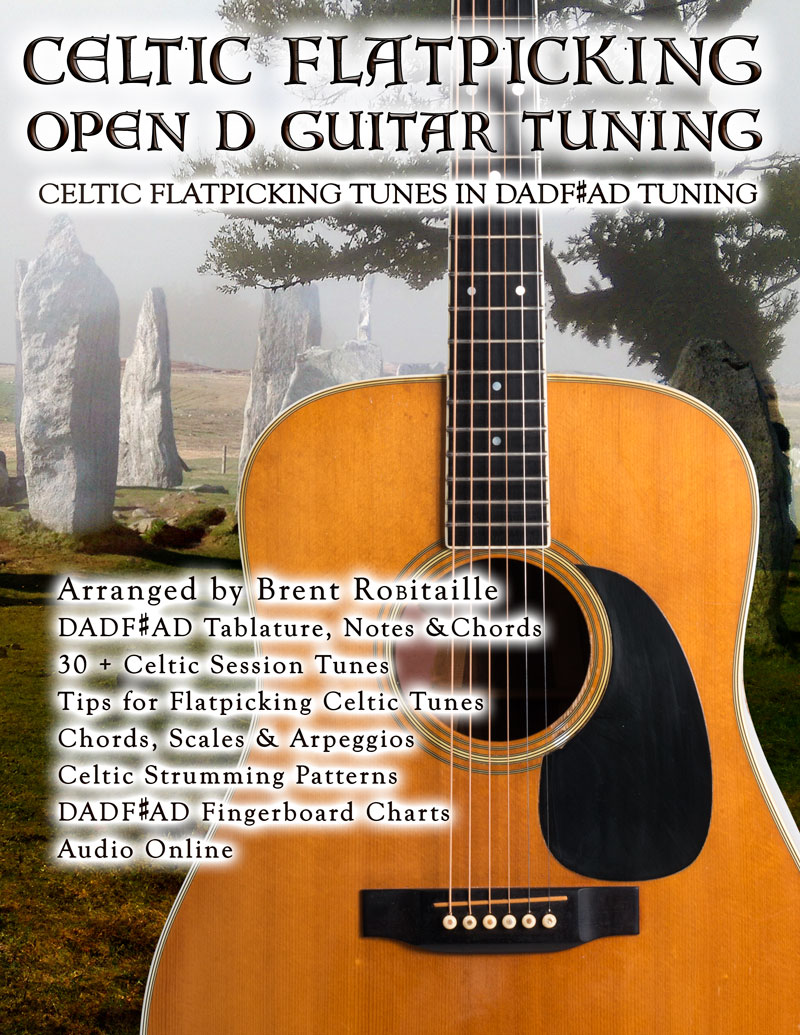Open D Guitar Tuning Minor Chords Lesson
In today’s lesson, we will continue to work on our Open D guitar tuning chords, but this time we will zone in on the secondary minor chords in the key of D. In this case: Em, F#m and Bm. We will also learn five popular chord progressions with open D minor chords.
If you missed the first lesson on Open D major chords, go here.
Open D (DADF#AD) has become a popular alternative to standard guitar tuning. The change in intervals between the strings forces a guitarist to practically relearn the fretboard. If you just dabble in Open D, you quickly realize, “I don’t know what I’m doing!”
However, once you begin to study the chords, you will see patterns and shapes just as you did with standard guitar tuning. There is not nearly as much music available in Open D though you can always adapt your current songs to the new tuning. Open D can add a new approach to your guitar playing.
Before we begin with the minor chords, here is a quick reminder of how to tune to Open D.
How to Tune to Open D Guitar Tuning
You will want to learn to tune by ear but at the start, use a guitar tuner until you’ve memorized the sound of the open D chord. To tune to Open D by ear from standard guitar tuning, follow these instructions:
- Play the open 4th string (D), and lower the 6th string down a whole step. Match the 4th string, so it sounds an octave lower than the 4th
- Now play the 4th string again and lower the 1st string down a whole step from E to D.
- You should have three D’s, one on the 6th, 4th and 1st. Try to get all three D’s in tune together.
- Finally, tune the 3rd string down a half step from G to F#. This is approximately a quarter turn on the tuning peg.
- I then play all the open strings and listen to any imperfections in the sound of the D chord.

Secondary Minor Chords in the Key of D
As you learned in the previous open D lesson, the primary chords in D major are D, G and A. These chords fall on the 1st (D), 4th (G), and 5th (A) degrees of the D major scale. In music theory, chords are written with roman numerals. So the primary chords are written like this: D (I), G (IV) and A (V).
With minor chords, we use small-case Roman numerals. So, the second chord in D major is Em (iim), the third chord is F#m (iiim), and the sixth chord is Bm (vim).
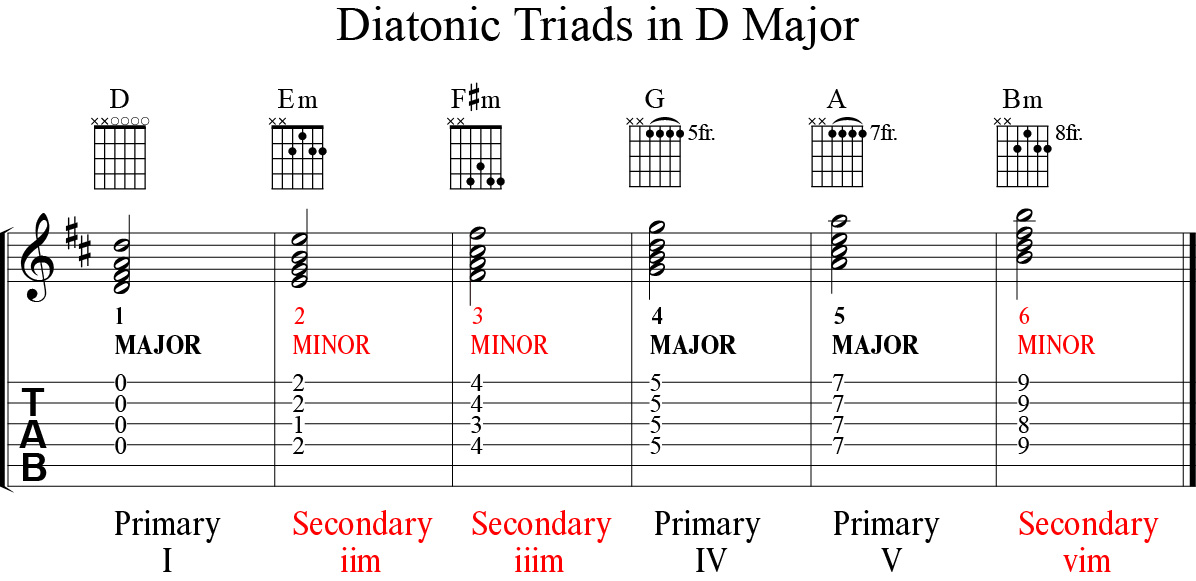
Now that you know the secondary minor chords in D major, it’s time to learn how to play them. First, we will learn E minor chords up to the 12th fret.
Interested in learning blues riffs and solos in Open D? Check out my book “101 Blues Riffs in Open D”
E Minor Chords in Open D Tuning
I will stick to four-string chords again in this lesson. Feel free to add or subtract as many notes as you like from the other strings. As long as there is an E, G and B in the minor chord, you are good to go.
Watch the video to learn 12 ways to play an E minor chord:
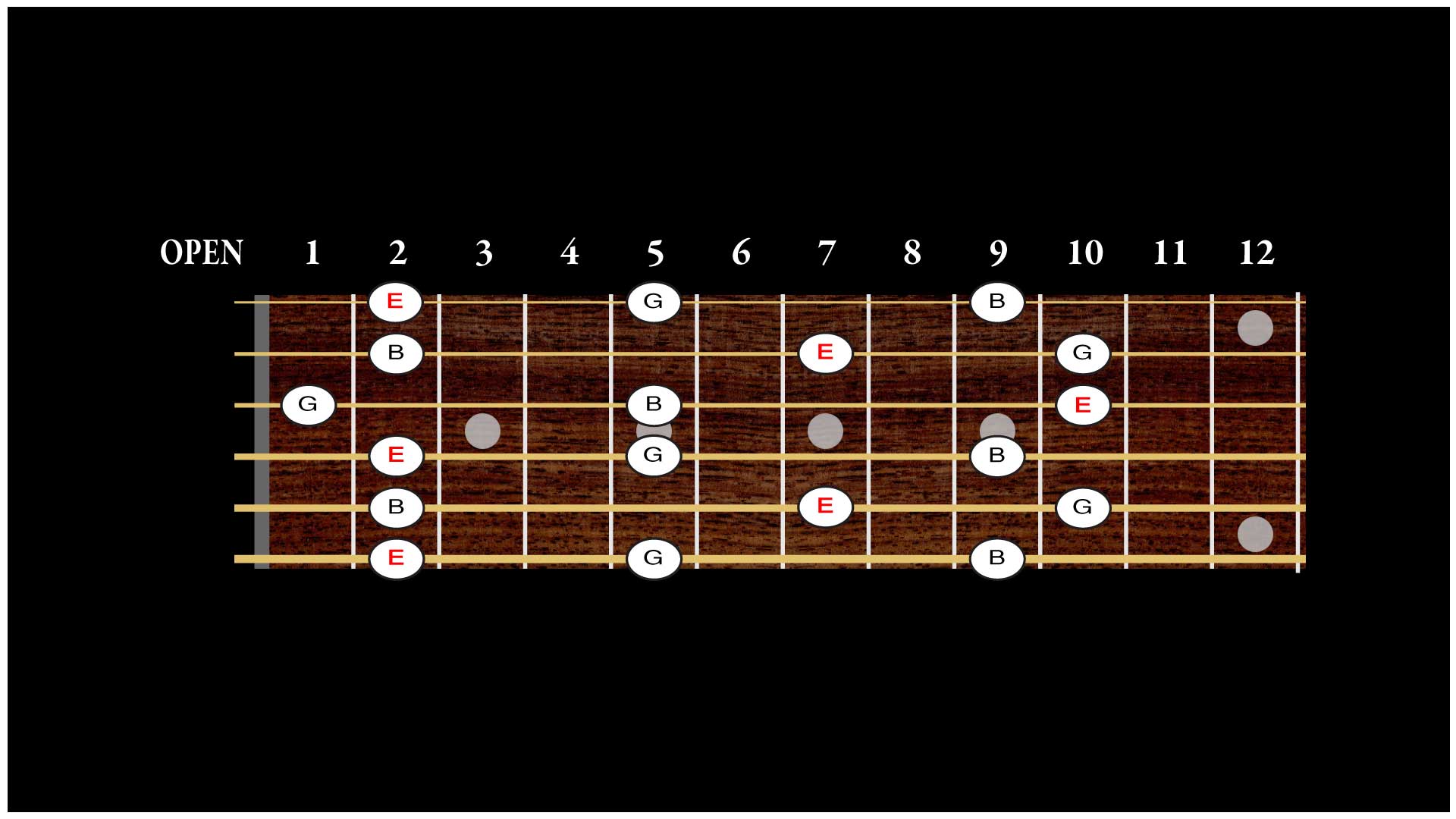
Em Minor Chord Inversions
As in the previous lesson, we will convert the notes of the chords into geometrical shapes. In the diagram below, we will take the notes of the E minor chords, which is the second chord in D major. The root note is a square, the b3rd is a triangle, and the 5th of the chord is a circle. There are three ways to rearrange the notes in Em:
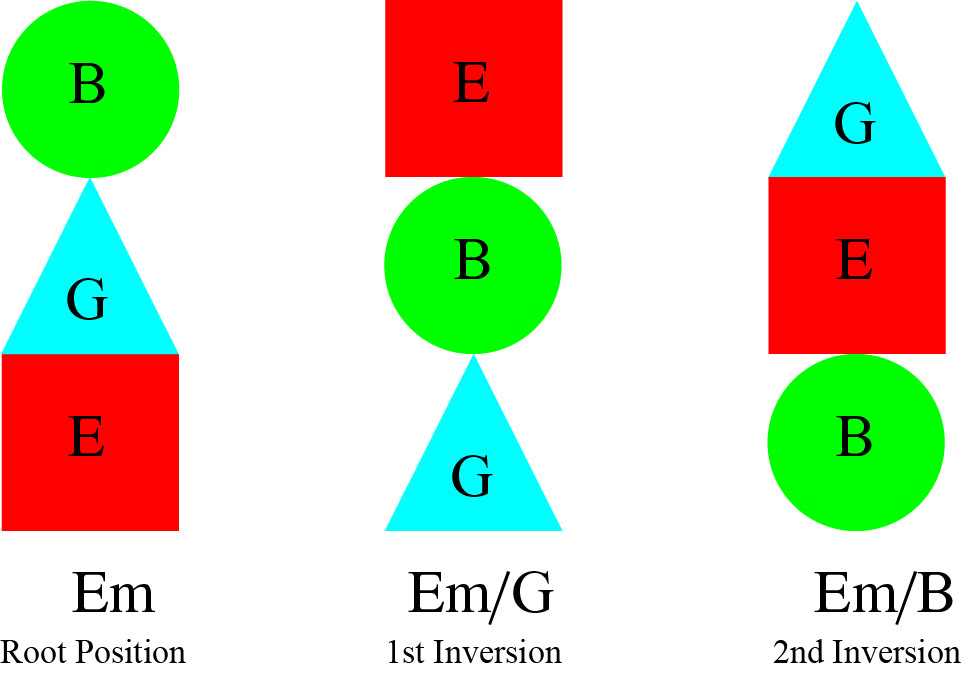
And as long as we play the 3 notes together, we are playing the Em chord. If E is the lowest-sounding note, we play an E minor in root position. When the G is the lowest note, we play an E minor in first inversion, sometimes written with a slash: E/G. If the B is the lowest note, then we are playing an E minor chord in 2nd inversion. This chord is sometimes written like this: E/B
All three are Em chords but have different harmonic functions and sound. Generally, the root position is preferred, while the 1st and 2nd inversions are used as transitional chords (E/G) or substitute dominant chords (E/B).
It’s a good idea to memorize the minor chord shapes in the video as they can be transposed to different keys, which will greatly expand your chord repertoire.
Let’s move on to the third chord of D (iiim): F# minor.
Love Open D? Have a look at the Classical Guitar Book in Open D Tuning.
F# Minor Chords in Open D Tuning
You will start recognizing the minor chord shapes moving up a tone or two frets. All the chords are moveable, meaning you just take the chord and shift it down the neck. Here are the notes of the F#m chord in Open D tuning:

Now watch the video to learn 12 F#m chords:
Finally, we can learn the B minor chords in Open D tuning.
The B Minor Chord in Open D
So, now you know the three secondary minor chords in D major. You will see many of the same shapes as you change into different keys. Always keep in mind the open strings to add different voicings and drone notes.

Now watch the video to learn 12 Bm chords:
How about now we try a few Open D chord progressions that use minor chords?
Five Popular Songs in Open D Tuning with Minor Chords
Here are five popular songs using Open D tuning that have minor chords. The songs are Hurt (Johnny Cash), Creep (Radiohead), Hotel California (Eagles), Hallelujah (Leonard Cohen) and Wicked Game (Chris Isaak). You can strum them or apply a fingerpicking pattern of your choice:
Can you play a 12-bar blues in Open D guitar tuning? Check out this lesson here.
Want to learn 36 major chords in Open D guitar tuning? Check out the Open D Guitar Chords Major Lesson.
More Theory – Secondary Minor Chords
Here is a chart of all the secondary minor chords in other keys:
| Key | I Major | iim | iiim | IV Major | V Major | vim |
| C | C | Dm | Em | F | G | Am |
| G | G | Am | Bm | C | D | Em |
| D | D | Em | F#m | G | A | Bm |
| A | A | Bm | C#m | D | E | F#m |
| E | E | F#m | G#m | A | B | C#m |
| B | B | C#m | D#m | E | F# | G#m |
| F# | F# | G#m | A#m | B | C## | D#m |
| C# | C# | D#m | E#m | F# | G# | A#m |
| F | F | Gm | Am | Bb | C | Dm |
| Bb | Bb | Cm | Dm | Eb | F | Gm |
| Eb | Eb | Fm | Gm | Ab | Bb | Cm |
| Ab | Ab | Bbm | Cm | Db | Eb | Fm |
| Db | Db | Ebm | Fm | Gb | Ab | Bbm |
| Gb | Gb | Abm | Bbm | Cb | Db | Ebm |
Check back again for more Open D guitar lessons. Subscribe for new lessons, and check out our Open D books and sheet music arrangements.
101 Blues Riffs and Solos in Open D Guitar Tuning
Take your Open D guitar playing to the next level with “101 Blues Riffs & Solos in Open D Guitar Tuning.” The most complete instructional book ever written exclusively in DADF#AD tuning. Using a combination of slide, fingerstyle and pick playing, you will cover all the bases needed to develop a solid technique in open D guitar. Everything you need to master the blues with essential lessons in DADF#AD guitar tuning!
• Master the Blues in Open D Guitar Tuning
• Slide, Fingerstyle and Picking Riff and Solos
• Traditional, Delta, Rock, Funk and Jazz Blues
• Extensive Scale, Chord, and Arpeggio Charts
• A Complete Course for Open D (DADF#AD)
• Audio Tracks Below
Classical Guitar Book in Open D Tuning
45 New Arrangments for Classical Guitar Players in Open D Tuning
• Tablature, Notation, Fingerings, and Performance Markings
• 24 of Giuliani’s right-hand technical exercises arranged for Open D
• Scales, arpeggios and chords to master the fingerboard
OPEN D (DADF#AD) Guitar Chord and Fingerboard Posters
This two-poster guitar chord set is an excellent reference for creative guitarists exploring the world of altered tunings in Open D tuning (DADF#AD).
Celtic Flatpicking Open D Guitar Tuning
Celtic Guitar Flatpicking in Open D Guitar. Tuning your guitar to DADF#AD or “Open D” tuning compliments Celtic guitar music perfectly. 30+ Celtic session tunes and songs. Jigs, reels, songs, hornpipes, waltzes, plus useful tips for Flatpicking and ornamentation. DADF#AD chords and arpeggios, Celtic strumming patterns, Campanella major, minor and modal scales, plus a DADF#AD fingerboard chart.

